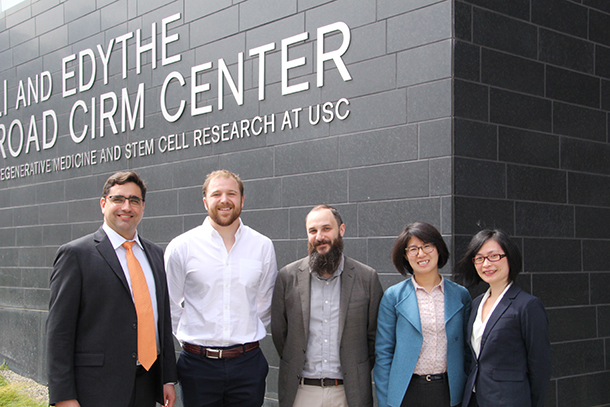When physicist Richard Feynman died in 1988, he left a message scrawled across his chalkboard: “What I cannot create, I do not understand.” Twenty years later, scientists in a very different field repeatedly invoked his words at the Junior Faculty Candidate Mini-Symposium, hosted by the Keck School of Medicine of USC’s Department of Stem Cell Biology and Regenerative Medicine on March 13.
Maxwell Z. Wilson, PhD, from Princeton University shared how he uses genetic tricks to “build” light-sensitive signaling molecules. This enables him to use light to precisely control the behavior of cells — an approach known as optogenetics. Visible light, infrared light or darkness can change the density and location of key proteins, which influence important cell behaviors such as communication and metabolism.
“I think that the ramifications of this work are going to go way beyond metabolism,” Wilson said. “After all, everything that happens in the cell is just a bunch of molecules interacting. And these tools can be used to create these crucibles of molecular interaction of any molecules you desire.”
In the future, he intends to use light to exert control over what he calls “nature’s ultimate designer” — proteins called Wnt signals that regulate embryonic development.
Andres Matias Lebensohn, PhD, from Stanford University School of Medicine continued the conversation about Wnt signals, mentioning their additional role in certain cancers — including 90 percent of cases of colon cancer. He revealed previously unappreciated mechanisms that regulate Wnt signaling and therefore could be targeted to treat cancers.
“In my lab, I want to dissect molecular mechanisms underlying new regulations in developmental signaling in order to learn about the basic biology of signaling pathways; understand the qualities that allow these mechanisms to generate different biological outcomes in physiology; and use this knowledge to manipulate the pathways therapeutically in regenerative medicine and cancer,” he said.
Seth Shipman, PhD, from Harvard University “built” a new tool for recording data about biological events in living cells over time. This tool is a “molecular recorder” that lets cells store this data in their own DNA — which scientists can read using genetic sequencing. Shipman has piloted this tool in bacteria and eventually wants to apply this approach in mammalian cells to record the brain’s developmental events, including the ones that lead to neurodevelopmental and neuropsychiatric diseases.
“What I really want are recipes to make each cell type in the brain,” Shipman said.
Pulin Li, PhD, from the California Institute of Technology harnessed the power of synthetic biology to study a developmental signal known as Sonic Hedgehog (SHH), which helps drive the embryonic formation of the central nervous system, limbs, teeth and other tissues. She not only revealed intricate details of SHH, but also an approach to amplify or dampen key developmental signals or, in the future, hormones.
In the future, Li said that she will apply this approach to “two particularly interesting multicellular behaviors … one is tissue patterning, the other is the hormone oscillations in our body.”
Yejing Ge, PhD, from The Rockefeller University talked about when stem cells have identity crises in response to injury. She examined stem cells that simultaneously possess the genetic hallmarks of both skin cells and hair follicle cells — a phenomenon called “lineage infidelity” that is useful for producing the variety of cell types needed to heal wounds. However, if lineage infidelity persists long-term due to a chronic wound or irritation, these stem cells can go rogue and produce cancer.
“Can we understand cancer by going back to ask how normal stem cells deal with stress, in this case wound repair?” Ge asked.
In the future, she plans to use sophisticated genomics tools to study lineage infidelity in health, disease and aging.
Andy McMahon, PhD, W.M. Keck Provost Professor of Stem Cell Biology and Regenerative Medicine and Biological Sciences; chair of stem cell biology and regenerative medicine; and director, Eli and Edythe Broad Center for Regenerative Medicine and Stem Cell Research at USC, called the mini-symposium “the highlight of our year, where we have an opportunity to celebrate diverse science from part five stellar young junior faculty candidates.” He added, “It’s a diverse group looking at a variety of different problems with an extraordinary variety of inventive approaches that they’re bringing to those problems.”
— Cristy Lytal


